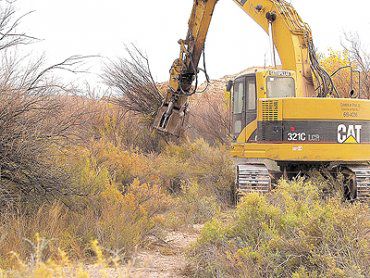Aquatics Biologist Kenny Breidinger reported to the Emery County Public Lands Council on the San Rafael River Restoration project. This project has been ongoing for the past two years and progress is being made. Nine native fish species have been identified in the drainage and one is a tier one sensitive species. “We are attempting to restore the San Rafael River to a more natural and functioning eco system for the benefit of all,” said Breidinger. One of the worries associated with the project is the listing of the round tail chub. There is a good probability it could be petitioned for listing. This restoration project will help with the fish habitat so hopefully the chub will not be listed. There are problems associated with the listing of sensitive species and the DWR is working hard to avoid any listings.
The invasion of the tamarisk has led to steep high banks and channel incision. Another problem along the drainage is the Hatt diversion which is 16 feet high; creating barriers and isolated fish populations. The Hatts have been long time owners at the Hatt Ranch and have been on the property a long time. They were useful in giving the DWR information on how the San Rafael River has changed over time.
A committee was formed, consisting of representatives of land and water users and managers, to address these issues. The committee consists of representatives from the Division of Wildlife Resources, Bureau of Land Management, Utah State University, Emery County Water Conservancy District, Emery County Mosquito and Weed Abatement, Utah Association of Conservation Districts, PacifiCorp Energy, the Tamarisk Coalition, Emery County and the Natural Resource Conservation Service.
The DWR has been working in partnership with the Natural Resources Conservation Service and Utah Partners for Conservation Development. The first steps toward restoration of the San Rafael River watershed began with the tamarisk removal along 122 acres of stream bank.
Breidinger said the fish are good in the upper part of the San Rafael River and they are working to reestablish connectivity throughout the entire river system by removing or modifying structures which limit fish passage. Breidinger said the Hatt diversion presents a problem and they aren’t sure yet what approach they are going to take there yet. They will work to remove non native fish within the river and prevent further invasion of nonnative species. A PIT tag reader has been installed at the Chaffin Ranch to determine fish movements and use of the San Rafael River.
On the tamarisk removal of 1,050 acres so far 322 acres have been completed. They will also work to reseed the areas where tamarisk has been removed with a native seed mix including willows and cottonwoods in the riparian areas. Beetles will also be released on any resprouts in the area. The DWR has hired a graduate student who is recording the history of changes along the San Rafael River and will also record the effectiveness of restoration efforts. Funding was secured to perform geological data gathering. Bat housing structures are currently being designated for installation on the new and old Highway 24 bridge. The restoration project will remove 60 miles of tamarisk along the drainage and improve efficiency. It isn’t known what affect this tamarisk removal will have on the water supply. It’s hoped enough water will be saved so it can be put to beneficial use.
The ecosystem as it exists today along the San Rafael isn’t functioning properly and the goal of the project is to make it a more functioning system. The goal is for long term improvements and benefits to the area. Some of the native vegetation is still present and with the tamarisk removal it is hoped the native vegetation can reestablish.
The San Rafael has been listed as one of the most degraded water systems in Utah. Seasonal dewatering, massive bank erosion and sedimentation have resulted in severe damage to the river and associated riparian habitat. Without restorative action, the river system would be lost.
A leading culprit, responsible for river degradation, is the tamarisk or salt cedar. Rehabilitation efforts will target this invader. A generation ago, the tamarisk was introduced from Eurasia, because of its value in controlling erosion. Unfortunately, the natural controls that kept the species within limits in Eurasia are absent here. Lacking nature’s biological restraints, the salt cedar has run rampant in the western United States.
Rehabilitation work of the San Rafael River bottomland is now occurring about five miles south of I-70 on the Hatt Ranch. Using track excavators with rotary grapples, equipment operators are plucking tamarisk from the ground and stacking the slash for burning. This year, the plan is to remove salt cedar from 122 acres of stream bank.
Several characteristics of this tree/shrub species combine to make this plant so destructive. The tamarisk excretes salt, poisoning the surrounding soil and preventing the growth of other species. Its growth habit is a thick jungle-like tangle, which excludes sunlight, and further prevents the establishment of other plants. The fire hazard produced by its woody mass and its enormous consumption of water combine to make this species one of the least desirable of all nuisance plant species.
Elimination of tamarisk and restoration of native streamside vegetation will result in benefits to sensitive fish species, birds and terrestrial wildlife. Native plant species, such as willow and cottonwood, will have the opportunity to return to their former habitat. The waterway itself is expected to heal with improvements in water quantity and quality.
This project is part of a larger restoration effort to address all of the impacts to the San Rafael drainage.
Anyone with additional questions may contact Kenny Breidinger, DWR native aquatics biologist, at 435-613-3722.
San Rafael River Restoration project

"The tamarisk are plucked from along the San Rafael River as part of the restoration project."
